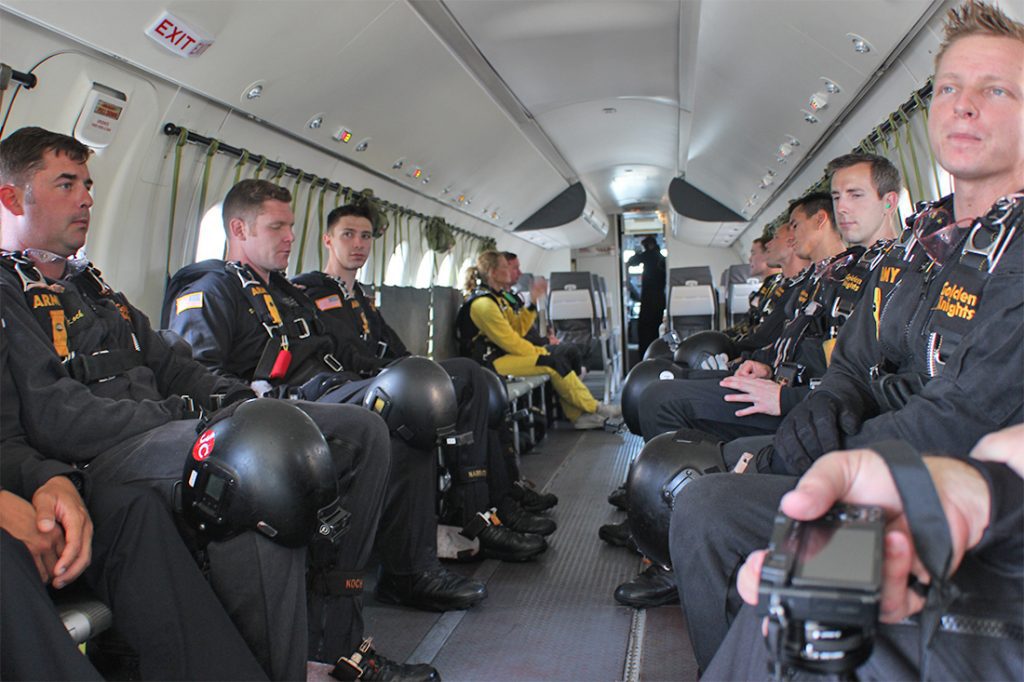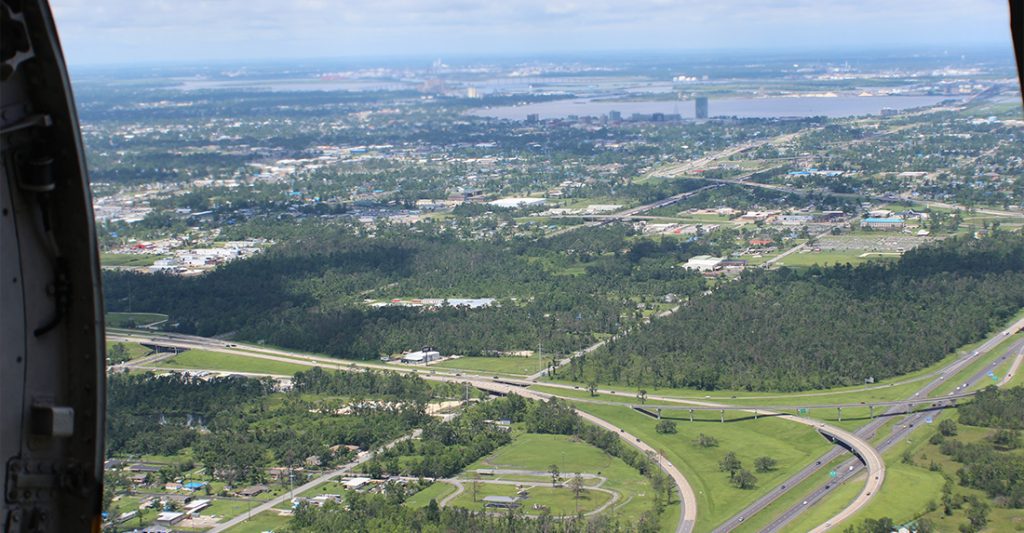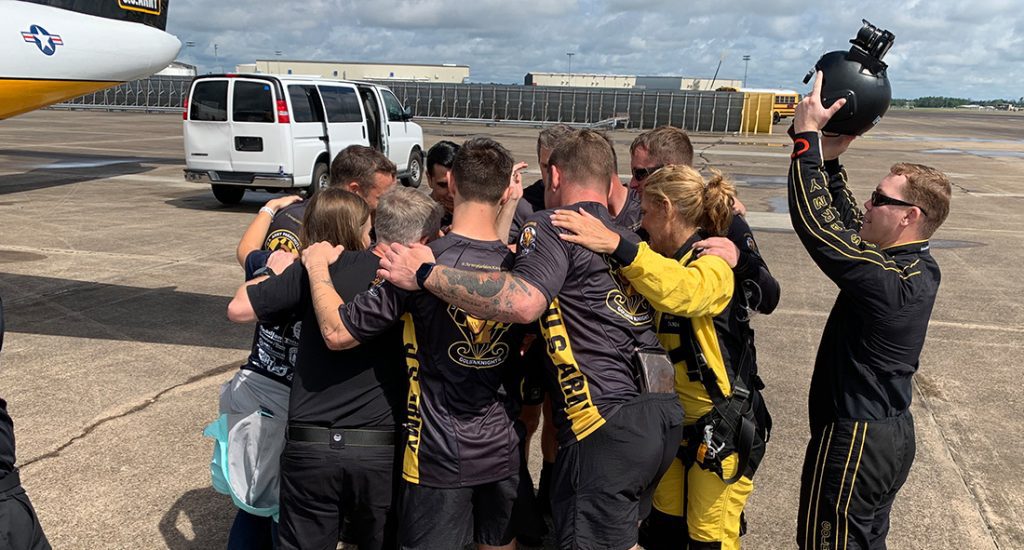Behind The Scenes With The US Army’s Golden Knights Parachute Team
Story And Photos By Bill Coyne
It was a five-year-old kid living just a few miles from Castle Air Force Base in Merced, Calif. I remember the lights from the airport beacon sweeping above my window at night, putting me to sleep as I counted the flashes.
During the day, it was almost a regular occurrence — the fighter pilots. breaking the sound barrier and creating a sonic boom heard throughout the valley. The single pane windows on the house rattled from the concussion. My heart skipped a beat and goosebumps formed as the jets pierced the air, the rumble of thrust trailing away.
Castle AFB was my first airshow experience. It was one thing to watch the ac- tion in the skies, but it was a completely differ-ent thing to be able to view the jets, bombers and support vehicles in person. When I was that close, meeting the pilots and crews who kept the machines airworthy, I was mesmerized.
Many years later, I find myself here in Lake Charles with an airshow right in my backyard. My office sits near the end of the Chennault runway. When the air-show comes to town, there’s a lot of activity in the air, especially the day before with a full rehearsal, This year, I finished my work early on Friday to the practice run. Armed with my camera and several lenses, I picnicked in catch the bed of my pickup truck. There was a strong likelihood this was going to be my best opportunity to view the planes, given that the weather was extremely unfavorable for the weekend airshow, and I was snapping the shutter. During a short break between performances, my phone rang. I didn’t recognize the number. When I answered, I heard the voice on the other end say, “Mr. Coyne, I am with the Chennault Airshow and I would like to invite you to ride along with the United States Army Golden Knights Parachute Team as a media member tomorrow. Would you be interested?” I was geeking out at the invite, but also looking around for cameras in case I was being punked. “Yes sir,” I replied. “Thank you. I would love this opportunity.”
He filled me in on my detail for the next morning. I finished the afternoon and headed home to a rain which would last throughout the night. Although my excitement was soaring, I needed to remain grounded due to the weather forecast.
Waking Saturday morning, the first thing I did was check the radar through my weather app. I was elated to see the storm had cleared out overnight. The sun was beginning to rise, revealing broken clouds overhead. A text message came through from my Golden Knights POC, SPC Raine Fuller, advising me to wear warm clothing and a jacket, as it would be cold at the high elevation. I gathered my equipment, kissed my wife as I exited the house and drove to the airport, and specifically, to my rendezvous point, Million Air. When I walked into the FBO, I had my opportunity to meet Brett Downer, the gentleman who extended this amazing invite. I was given my press pass, a few instructions and turned over to the crew of The Golden Knights. I and media mogul Peter O’Carroll were to be briefed on the upcoming flight.
After a few minutes of introductions and a ground run practice on the tarmac, we shuffled into the rear of the aircraft — a newly acquired DHC-8-300 turbo-prop, perfect for skydiving. A 5-foot by 5-foot jump door remained open as we all got strapped in and secured our camera gear. The temperature was climbing as the sun beat down on the fuselage. Bundled up in anticipation of the colder temperatures to come, we all began to sweat.
The pilots, finishing up their preflight checks, ignited the twin turbine prop engines. The aroma of exhaust filled the cabin. As the blades began to swirl, a little temperature relief was provided. Eleven U.S. Army sol-diers climbed on board. The steps were retracted, the front door slammed shut and we began to taxi. Everything about this show is related to precise timing and execution. From my seat, the open door was only inches away. I saw the pavement of the runway flowing by as we moved down the taxi runway. One gradual turn to the right positioned the aircraft in the center of the main runway. Without hesitation, the pilot throttled up and the engines responded as the speed increased. The noise prohibited any conversation. This was an airshow and not a gentle commercial flight. The takeoff was steep and abrupt. I couldn’t help but notice the abundance of blue tarps still covering roofs, a reminder of the recovery and rebuilding still needed for hard-hit Southwest Louisiana.
The climb paused at an elevation of 3,000 feet. We circled the runway below. Armed with streamers, three of the men knelt at the open door to drop the ribbons which would indicate wind direction for the skydivers. A hefty slap on the floor could be felt in the cockpit where the pilots marked the spot on the GPS. Moments later, another slap confirmed the streamers had reached the ground.
The ascent continued. As we rose above the spotty cloud cover, the temperature continued to drop, with the wind chill swirling throughout the cabin. Some of the men engaged in conversations, some told jokes, some ran the jump sequence through their mind. SPC Fuller took in the view from the best seat in the house.
The Dash-8 plateaued at 13,000 feet and went into a holding pattern. The air temperature was 35° F. As we got closer to jump time, the men readied themselves with fist bumps, hollers and hype-ups. The pilot triggered the green jump light, indicating it was go time. With that cue, a single soldier readied at the door. “Ready, set … GO!” he exclaimed as he saluted upon his exit, free-falling to speeds of 120 mph as he began the show with a single trail of red smoke.
The jump light went to standby. The rest of the men prepared themselves as they stood in line down the center of the fuselage. Among them was a tandem jumper who was a public figure: United Way CEO and president Denise “Denny” Durel.
As the seconds ticked down to jump time, the parachute team began to huddle near the open door.
The closer the intervals between the times when the jumpers go through the door, the less time they spend regrouping as they plummet to earth. The light went green, and in a split second, eight men and one woman filed out the door and triggered the smoke cans as they fell through the sky. And just like that, there was nothing left but a couple of pilots and three guys with cameras.
There was an all clear and the plane began its descent. From a level flight at 13,000 feet, the nose of the aircraft dipped and the speed increased. The wind and noise were a rush as we punched through the cloud cover.
he temperature rose steadily by the second. The humidity increased and the condensation coated the camera lenses, which had nearly been at the point of freezing only moments earlier. Of course, the lenses were now useless. The details of homes and people on the ground gradually became easier to see. After a hard bank there was a 300-mile-an-hour low-level pass across the runway as the pilots showed off the beauty of the Golden Knights aircraft to the spectators below before touching down.
When I had left my house earlier, my wife had said to me, “I know you’re on cloud nine. Go have fun.” I can tell you, there are many levels above cloud nine, and I found them.
I’m honored to have been a part of this flight; to have experienced this with the amazing men and women of the U.S. Army Golden Knights Parachute Team and our military. Thank you to all for an amazing day.






















Comments are closed.